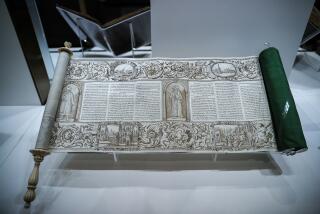‘The YIVO Encyclopedia of Jews in Eastern Europe,’ Gershon David Hundert, editor in chief
The YIVO Encyclopedia of Jews in Eastern Europe
Gershon David Hundert, editor in chief
Yale University Press: Two volumes, 2,400 pp., $400
Say “the six million” and some will know what you mean, that you’re referring to the number of Jews killed in the Holocaust. But knowledge of who those people were and what the outline of their world might have been has been much harder to come by.
More than that, our lack of knowledge puts us in danger of having that massive, undifferentiated number stand in for a sophisticated, nuanced reality. Was that world-that-is-no-more really “Fiddler on the Roof” all the time, or was something much more complex going on? Getting an essential and authoritative sense of that obliterated past -- “far more varied -- and conflicted -- than a sentimental vision of the shtetl would imply” is how one scholar put it -- has been beyond the capacity of nonspecialists for more than six decades. One book has just changed that. Forever.
Beautifully published by Yale University Press, “The YIVO Encyclopedia of Jews in Eastern Europe” actually comes in two volumes totaling 2,400 triple-columned pages. Some 450 scholars from three continents contributed articles on more than 1,800 subjects, starting with Shim’on Abeles, a boy of 17th century Prague whose father was accused of murdering him to keep him from converting, and ending with Zalmen Zylbercweig, a 20th century Yiddish theater historian.
“No publication has ever attempted to systematically represent the entire historical legacy of this culture until now,” says Carl Rheins, the executive director of YIVO, the New York-based center for scholarship about Eastern European Jews under whose auspices the encyclopedia was put together, and it’s hard to argue with him.
The result of that attempt is a fiendishly comprehensive look at a civilization so unexpectedly multifaceted that it’s best viewed as a Yiddish-speaking Atlantis, a lost world buried forever by the volcano of Nazi mass murder.
Yes, there are 220 rabbis and other religious leaders with their own entries, as well as dozens of different Hasidic dynasties. And 24 pages are devoted to Yiddish literature, including 128 mini-biographies of writers not quite worthy of full encyclopedia entries.
But though that kind of high-culture thoroughness might be expected, we also meet flyweight Stanislaw Rotholc (1912-1996), the first Jewish boxer to become a Polish national champion, and Zishe Breitbart (1883-1925), a Yiddish-speaking circus strongman who, “flanked by the Zionist flag,” regularly “bent rods into horseshoes, bit through chains, and pounded nails into boards with his fist” not to mention balanced a platform of motorcycles on his stomach. You could look it up.
Also profiled are photographer Evgenii Khaldei, who took the memorable World War II photo of the Soviet flag flying over the captured Reichstag in Berlin, and the odd-couple comedy team of Dzigan and Shumacher, who performed even while imprisoned during the war. And the entry for entertainers reveals such notables as a wrestler known as “the Son of Rubber” and Moyshe Shtern, “a Jewish fakir whose performances as ‘Takhra Bey’ featured the artist piercing his face and body with needles.”
The notion with all of this, editor in chief Gershon David Hundert explains in the preface, is to present that lost world “in a dispassionate manner, as accurately and fully and precisely as possible -- not to celebrate or eulogize but to recover and represent . . . without bias and without nostalgia but as comprehensively and as objectively as possible.”
To accomplish this, the encyclopedia has first of all contacted the top scholars in the field. For instance, we have the pleasure of reading Ruth Wisse on poet and short-story writer Y.L. Peretz, Dan Miron on S.Y. Abramovitsh (“the founder of modern artistic prose in Hebrew and Yiddish”) and Arthur Green on controversial Hasidic rebbe Nahman of Bratslav. The editors have also ventured outside the academy when necessary, with Village Voice film critic J. Hoberman writing on cinema and “Born to Kvetch” author Michael Wex on humor, and, more than that, they insisted that the writing be not stiflingly academic but readable.
More than accessible, the “YIVO Encyclopedia” is so compulsively browsable that you can disappear within its pages for hours without a trace, the equivalent of diving into the coolest, deepest of pools. These volumes should come with a warning label, cautioning the time-challenged that they are entering at their own risk.
Keeping the pages lively are more than a thousand illustrations, including cartoons about cheating wives and photographs of chess players and criminals, of Hasidic rabbis on a spa visit and of a group of fusgeyers, Romanian Jews who walked to port cities to sail to America because they couldn’t afford rail fare.
Even more involving are the charts and tables that, in terms of comprehensiveness and willingness to map the unexpected, are remarkable.
Here, for instance, you will find a map of major pogrom sites and another pinpointing the location of centers for Misnagdim, sworn enemies of the Hasidic movement, where my surprise at seeing my father’s obscure home town, Volkovishk, was matched only by my astonishment at finding, a few pages later, an entry for a Hungarian mathematician named Pál Turán. Who knew?
The tables and charts are just as informative and surprising. There is an elaborate table illustrating the relationships among dozens of different Zionist parties, and there’s a two-page annotated list of 19 principal trials against Jews for “ritual murder” dating from 1494 to 1911. Even longer is the four-plus page section devoted to listing journals dealing with everything from literature to science to Zionism.
If the “YIVO Encyclopedia” gives one overall impression of the world of Eastern European Jews, it’s of a society in continual ferment on every imaginable front. There were conflicts among religious rabbis -- a 17th century sage known as Taz had disputes so intense they continued for decades after his death -- and battles so rancorous between conventional rabbis and the emerging Hasidic movement that Jews informed on other Jews to the government and even refused to marry people with the opposing viewpoint.
In time, however, the biggest disputes were between the forces of religion and the yearning on the part of succeeding generations to be part of the nonobservant secular world.
One of the refreshing things about this enormous endeavor is that though the shadow of the Holocaust looms, the encyclopedia refuses to dwell on it, insisting, in Hundert’s words, that its main focus “is on the life of Jews and not their murder or their murderers.”
“The YIVO Encyclopedia of Jews in Eastern Europe” accomplishes exactly what it set out to do, providing the most complete picture of this world we are ever likely to get. Anyone with an interest in culture, language, religion and politics will be fascinated by what’s between its covers; if your family comes from that part of the world, this is as close as you will ever come to truly possessing your past. *
Kenneth Turan is a Times film critic and former editor of the Book Review.
More to Read
Sign up for The Wild
We’ll help you find the best places to hike, bike and run, as well as the perfect silent spots for meditation and yoga.
You may occasionally receive promotional content from the Los Angeles Times.











